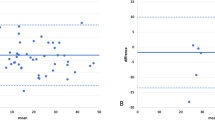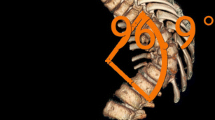Abstract
Purpose
Although adolescent idiopathic scoliosis (AIS) is known to impact the 3D orientation of the spine and pelvis, the impact of the vertebral position relative to the X-ray scanner on the agreement between 2D and 3D measurements of a curve has not been evaluated. The purpose of this study was to investigate the agreement between 2D and 3D measurements of the scoliotic curve as a function of the 3D spinal parameters in AIS.
Methods
Three independent observers measured the thoracic and lumbar Cobb angles, Kyphosis, and lordosis on the posterior–anterior and lateral X-rays of AIS patients. The 3D reconstructions were created from bi-planar X-rays and the 3D spinal parameters were calculated in both radio and patient planes using SterEOS software. The degree of agreement between the 2D and 3D measurements was tested and its relationship with the curve axial rotation was determined.
Results
2D and 3D measurements of the sagittal plane spinal parameters were significantly different (p < 0.05). The differences between the 2D and 3D measurements were related to the apical vertebrae rotation, the orientation of the plane of maximum curvature, pelvic axial rotation, and the curve magnitude. Differences between the radio plane and patient plane measurements were related to the pelvic axial rotation, Cobb angles, and apical vertebrae rotation, p < 0.05.
Conclusion
Clinically and statistically significant differences were observed between the 2D and 3D measurements of the scoliotic spine. The differences between the 2D and 3D techniques were significant in sagittal plane and were related to the spinal curve and pelvic rotation in transverse plane.








Similar content being viewed by others
References
Dansereau J, Beauchamp A, Guise JD, Labelle H (1990) Three dimensional reconstruction of the spine and the rib cage from stereoradiographic and imaging techniques. 16th Conf Can SocMech Eng 2:61–64
Cheriet F, Meunier J (1999) Self-calibration of a biplane X-ray imaging system for an optimal three dimensional reconstruction. Comput Med Imaging Graph 23(3):133–141
Kadoury S, Cheriet F, Laporte C, Labelle H (2007) A versatile 3D reconstruction system of the spine and pelvis for clinical assessment of spinal deformities. Med Biol Eng Comput 45(6):591–602
Kadoury S, Labelle H, Parent S (2014) 3D spine reconstruction of postoperative patients from multi-level manifold ensembles. Med Image Comput Comput Assist Interv 17(Pt 3):361–368
Nault ML, Mac-Thiong JM, Roy-Beaudry M et al (2014) Three-dimensional spinal morphology can differentiate between progressive and nonprogressive patients with adolescent idiopathic scoliosis at the initial presentation: a prospective study. Spine (Phila Pa 1976) 39(10):E601–E606
Labelle H, Aubin CE, Jackson R, Lenke L, Newton P, Parent S (2011) Seeing the spine in 3D: how will it change what we do? J Pediatr Orthop 31(1 Suppl):S37–S45
Kadoury S, Labelle H (2012) Classification of three-dimensional thoracic deformities in adolescent idiopathic scoliosis from a multivariate analysis. Eur Spine J 21(1):40–49
Sangole AP, Aubin CE, Labelle H et al (2009) Three-dimensional classification of thoracic scoliotic curves. Spine (Phila Pa 1976) 34(1):91–99
Lenke LG, Betz RR, Harms J et al (2001) Adolescent idiopathic scoliosis: a new classification to determine extent of spinal arthrodesis. J Bone Joint Surg Am 83-A(8):1169–1181
Lark RK, Yaszay B, Bastrom TP, Newton PO, Harms Study G (2013) Adding thoracic fusion levels in Lenke 5 curves: risks and benefits. Spine (Phila Pa 1976) 38(2):195–200
Cho RH, Yaszay B, Bartley CE, Bastrom TP, Newton PO (2012) Which Lenke 1A curves are at the greatest risk for adding-on and why? Spine (Phila Pa 1976) 37(16):1384–1390
Humbert L, De Guise JA, Aubert B, Godbout B, Skalli W (2009) 3D reconstruction of the spine from biplanar X-rays using parametric models based on transversal and longitudinal inferences. Med Eng Phys 31(6):681–687
Gille O, Champain N, Benchikh-El-Fegoun A, Vital JM, Skalli W (2007) Reliability of 3D reconstruction of the spine of mild scoliotic patients. Spine (Phila Pa 1976) 32(5):568–573
Al-Aubaidi Z, Lebel D, Oudjhane K, Zeller R (2013) Three-dimensional imaging of the spine using the EOS system: is it reliable? A comparative study using computed tomography imaging. J Pediatr Orthop B 22(5):409–412
Glaser DA, Doan J, Newton PO (2012) Comparison of 3-dimensional spinal reconstruction accuracy: biplanar radiographs with EOS versus computed tomography. Spine (Phila Pa 1976) 37(16):1391–1397
Ilharreborde B, Steffen JS, Nectoux E et al (2011) Angle measurement reproducibility using EOS three-dimensional reconstructions in adolescent idiopathic scoliosis treated by posterior instrumentation. Spin (Phila Pa 1976)e 36(20):E1306–E1313
Illes T, Tunyogi-Csapo M, Somoskeoy S (2011) Breakthrough in three-dimensional scoliosis diagnosis: significance of horizontal plane view and vertebra vectors. Eur Spine J 20(1):135–143
Somoskeoy S, Tunyogi-Csapo M, Bogyo C, Illes T (2012) Clinical validation of coronal and sagittal spinal curve measurements based on three-dimensional vertebra vector parameters. Spine J 12(10):960–968
Illes T, Somoskeoy S (2013) Comparison of scoliosis measurements based on three-dimensional vertebra vectors and conventional two-dimensional measurements: advantages in evaluation of prognosis and surgical results. Eur Spine J 22(6):1255–1263
Somoskeoy S, Tunyogi-Csapo M, Bogyo C, Illes T (2012) Accuracy and reliability of coronal and sagittal spinal curvature data based on patient-specific three-dimensional models created by the EOS 2D/3D imaging system. Spine J 12(11):1052–1059
Stokes IA (1994) Three-dimensional terminology of spinal deformity. A report presented to the Scoliosis Research Society by the Scoliosis Research Society Working Group on 3-D terminology of spinal deformity. Spine (Phila Pa 1976) 19(2):236–248
Morrison DG, Chan A, Hill D, Parent EC, Lou EH (2015) Correlation between Cobb angle, spinous process angle (SPA) and apical vertebrae rotation (AVR) on posteroanterior radiographs in adolescent idiopathic scoliosis (AIS). Eur Spine J 24(2):306–312
Schmid SL, Buck FM, Boni T, Farshad M (2015) Radiographic measurement error of the scoliotic curve angle depending on positioning of the patient and the side of scoliotic curve. Eur Spine J 25(2):379–384. doi:10.1007/s00586-015-4259-5
Villemure I, Aubin CE, Grimard G, Dansereau J, Labelle H (2001) Progression of vertebral and spinal three-dimensional deformities in adolescent idiopathic scoliosis: a longitudinal study. Spine (Phila Pa 1976) 26(20):2244–2250
Author information
Authors and Affiliations
Corresponding author
Ethics declarations
Conflict of interest
None of the authors has any potential conflict of interest.
Rights and permissions
About this article
Cite this article
Pasha, S., Cahill, P.J., Dormans, J.P. et al. Characterizing the differences between the 2D and 3D measurements of spine in adolescent idiopathic scoliosis. Eur Spine J 25, 3137–3145 (2016). https://doi.org/10.1007/s00586-016-4582-5
Received:
Revised:
Accepted:
Published:
Issue Date:
DOI: https://doi.org/10.1007/s00586-016-4582-5




